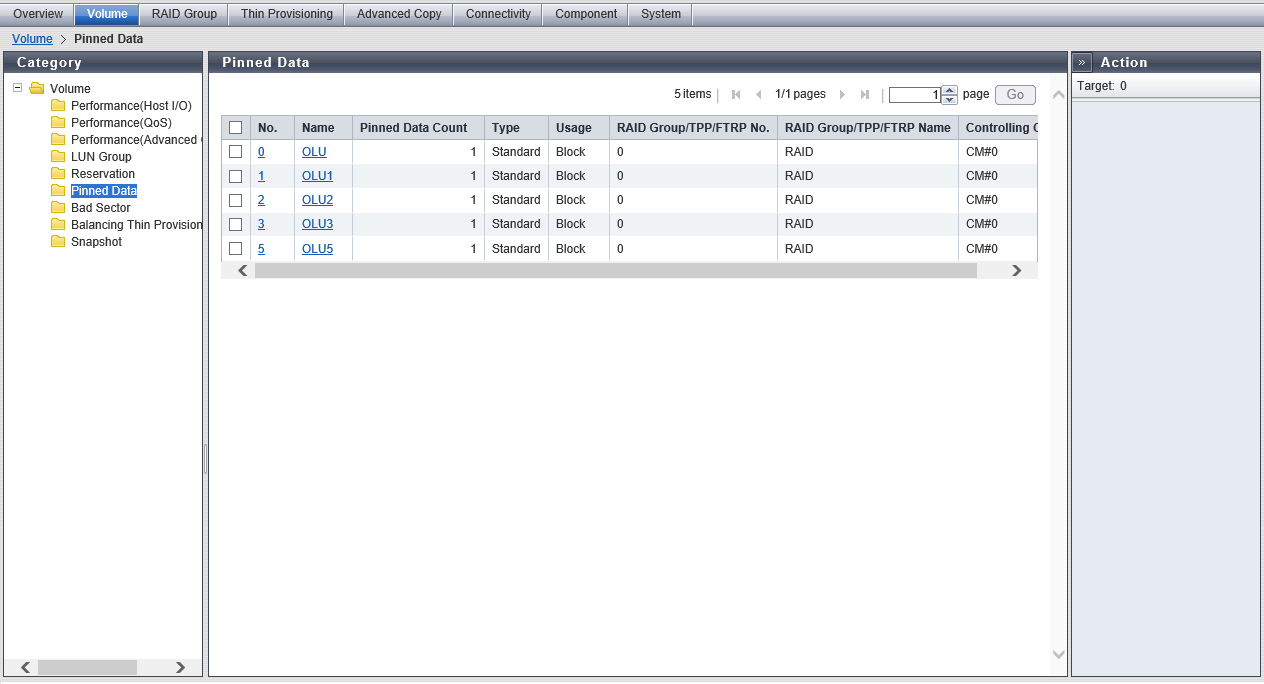Pinned Data
Overview
Volumes including pinned data are displayed.
When a system message that indicates the detection of pinned data is displayed in the [Overview] screen, or when a "Pinned data" event is notified by Host Sense Key Code Qualifier or SNMP Trap, use this function to check the detected pinned data.
Use the [Setup Event Notification] function to specify whether to perform event notification when pinned data is detected. Refer to the [Setup Event Notification] function for details. Note that writing back, deleting, and saving pinned data can be performed by a maintenance engineer who has the "Maintenance Operation" policy.
Deduplication/Compression Volumes are not displayed in the pinned data list.
Pinned data is not created for External Volumes.
User Privileges
Availability of Executions in the Default Role
| Default role | Availability of executions |
|---|---|
| Monitor | |
| Admin | |
| StorageAdmin | |
| AccountAdmin | |
| SecurityAdmin | |
| Maintainer |
Refer to "User Roles and Policies" for details on the policies and roles.
Display Contents
The volumes containing pinned data and the number of pinned data are displayed.

Volume List
| Item | Description |
|---|---|
No. |
The volume number is displayed. Click this item to display the [Volume Detail] screen ([Basic] tab). |
Name |
The volume name is displayed. Click this item to display the [Volume Detail] screen ([Basic] tab). |
Pinned Data Count |
The number of pinned data is displayed. |
Type |
The volume type is displayed. |
Usage |
The usage of the volume is displayed.
|
RAID Group/TPP/FTRP No. |
The following number is displayed:
|
RAID Group/TPP/FTRP Name |
The following name is displayed:
|
Controlling CM |
The Controlling CM of the RAID group to which the volume belongs is displayed. For the ETERNUS DX900 S5 or the ETERNUS DX8900 S4 CE#x CM#y For the other models CM#y x: CE number y: CM number |
[Volume Detail] Screen ([Basic] Tab)
Click the [Pinned Data] tab to display the detailed information.
[Pinned Data] Screen
The volume number, volume name, type, and usage are displayed.
| Item | Description |
|---|---|
LBA |
The location of the pinned data in the volume is displayed using a Logical Block Address (LBA) (hexadecimal). |
RC |
The cause (Reason Code) of the created pinned data is displayed (hexadecimal). |
SK |
The Sense Key (SK) part is displayed from the sense information that is output when the pinned data is created (hexadecimal). |
ASC |
The Additional Sense Code (ASC) part is displayed from the sense information that is output when the pinned data is created (hexadecimal). |
ASCQ |
The Additional Sense Code Qualifier (ASCQ) part is displayed from the sense information that is output when the pinned data is created (hexadecimal). |
Filter Setting
Function Description
Filter setting is a function used to display a list of only the pinned data meeting all the specified conditions.
No filtering is set by default. The following table shows conditions that can be specified.
| Item | Description | Setting values |
|---|---|---|
LBA |
Input the LBA that is to be displayed. When not using the LBA for filtering, leave this item blank. |
LBA Blank |
RC |
Input the RC that is to be displayed. When not using the RC for filtering, leave this item blank. |
RC Blank |
SK |
Input the SK that is to be displayed. When not using the SK for filtering, leave this item blank. |
SK Blank |
ASC |
Input the ASC that is to be displayed. When not using the ASC for filtering, leave this item blank. |
ASC Blank |
ASCQ |
Input the ASCQ that is to be displayed. When not using the ASCQ for filtering, leave this item blank. |
ASCQ Blank |



